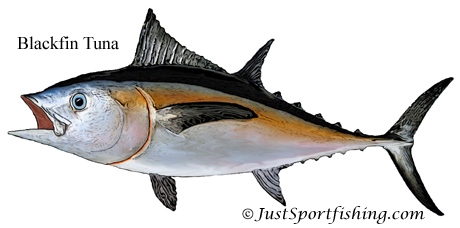|
|

How
to fish for Blackfin Tuna
The Blackfin Tuna are the smallest of the tunas, rarely reaching 30 pounds. They are found in the warmer waters of the western Atlantic. They can be caught offshore, but they will also move inshore and stack up along reefs and ridges where there is plenty of bait fish. Fishing methods for Blackfin Tuna include trolling whole baits such as mullet, mackerel, bonefish, ballyhoo, flying fish, and squid, as well as various types of artificial lures and sometimes strip baits.
Live bait for Blackfin Tuna include pinfish, pigfish and menhaden. Chumming and using live pilchards on straight 20 pound test with a 4/0 or 5/0 short shank hook has proven to be very effective for Blackfin Tuna also. Start a drift in front of your favorite spot or just power drift. Chum the water with pilchards one at a time, every ten to fifteen seconds. Watch for the tuna to start breaking the surface, when they get close throw freebees right to them along with your hooked bait; sometimes you can keep this going for long drifts.
Another great method for Blackfin Tuna is using live Ballyhoo. Beak hook a live Ballyhoo using the same style hook and no more than 30 pound leader put them way out behind the boat and slow troll or power drift, leave your bail open for the strike, but it is usually unnecessary to drop back to far.
If your bait just isn't getting bites then try trolling feathers with ¼ ounce to ½ ounce blue and white, red and white, black and red, straight 20 pound test. Use jigs or a fly that resembles the chum. Trolling skirts and spoons, jigs, and trolling feathers are all effective for catching Blackfin tuna. Trolling lures and chumming will work for catching Blackfin.
Ideal trolling speed depends on conditions. When the forage fish present are small and not showing on top, pulling lures that skip the surface can be a waste of time. Small trolling baits that track on or just beneath the surface can be the key. To Blackfin the appearance of weakness is often part of the attraction.
Tunas are boat shy. They often sound when a boat runs over them. If they're in a good concentration of bait, the fish will pop up again but you might need to troll baits 100 yards behind the boat to give them time to do so with calm and quiet conditions. Tunas are more aggressive when it's breezy, or when you have them strafing through a chum line .
Blackfins are known for avoiding the whitewater part of the wake behind a trolling boat; finding the quiet water with your lures is often the only way to get a hit. Every boat is different but a minimum trolling speed is typically six or seven knots when you scout for fish. Tunas can easily catch baits moving faster, if you give them time to settle down after you run over them.
Fishing little lures way back in the spread, while a proven tactic, has its own set of frustrations for the angler. For starters, the lures are tough to see back there. To perform at their best, tuna lures must run true; weeds can quickly spoil them
When trolling for tuna the larger baits don't catch as many fish as the smaller 6 or 8 inch baits. Chummed tuna can be quite line and hook shy.

|
JustSportfishing.com

|


